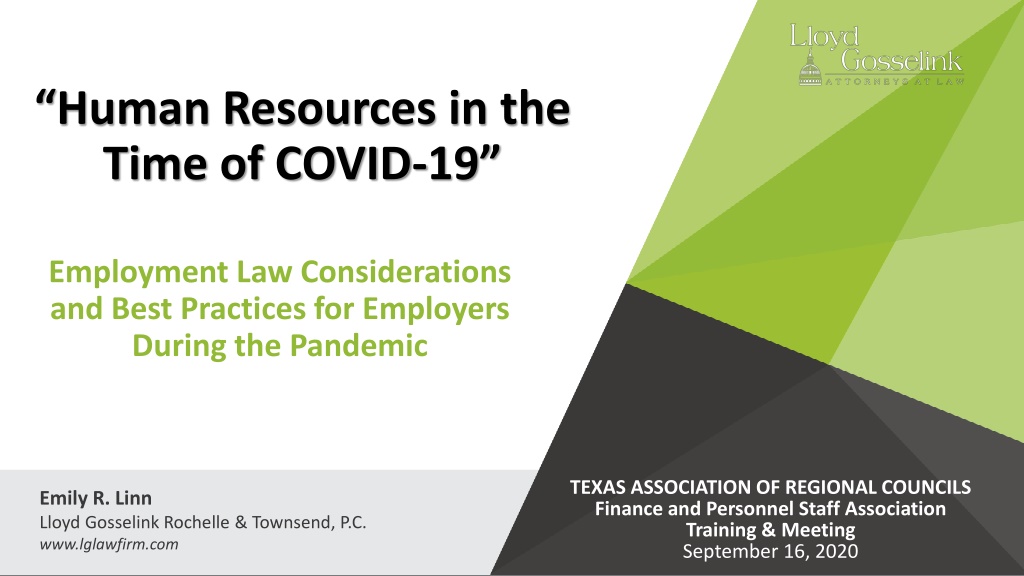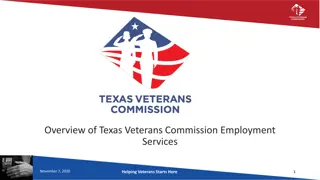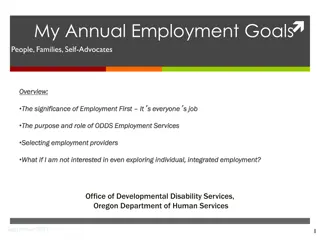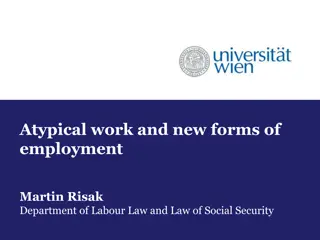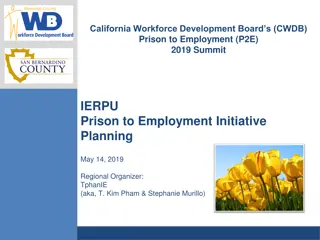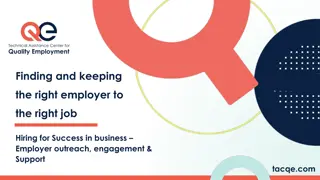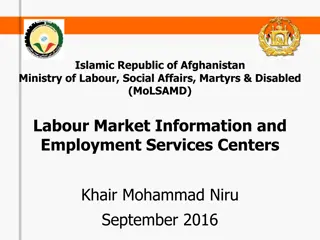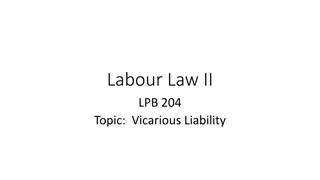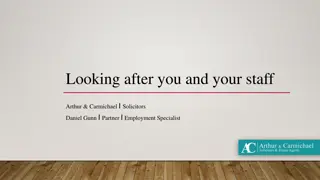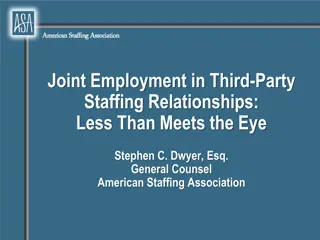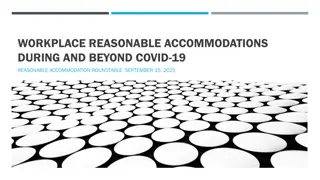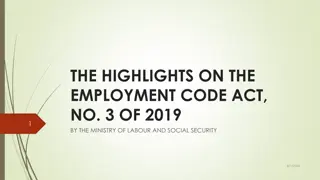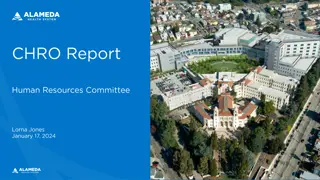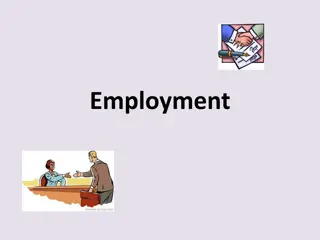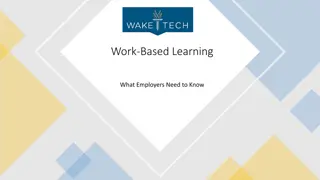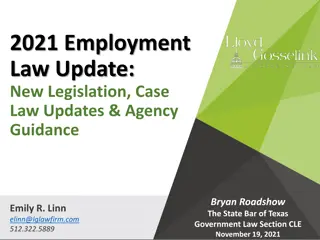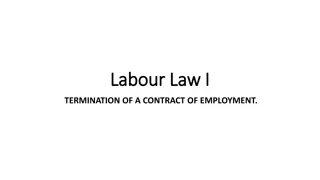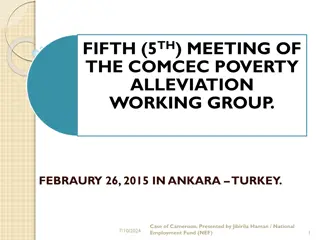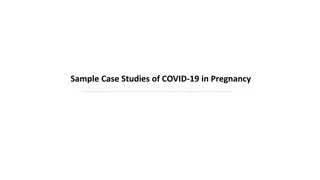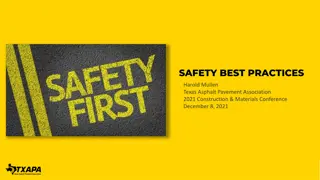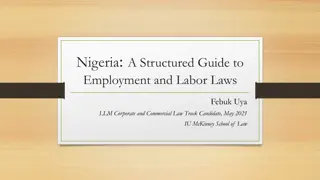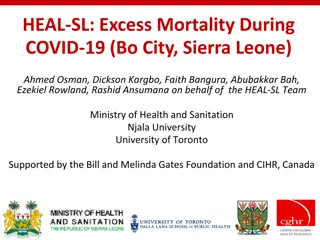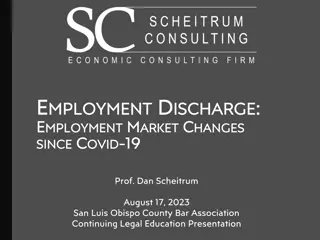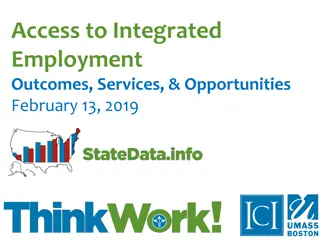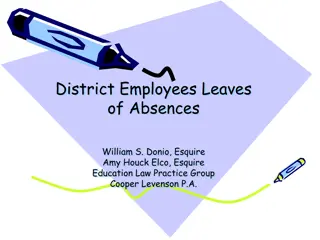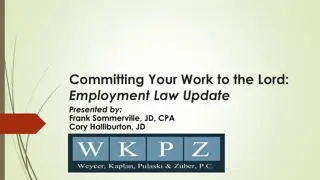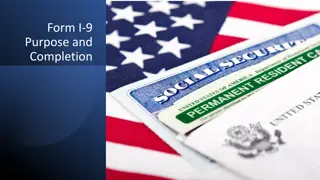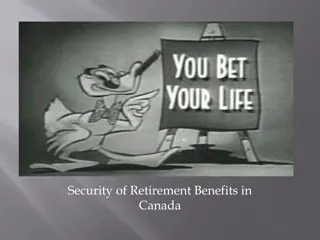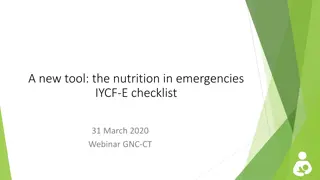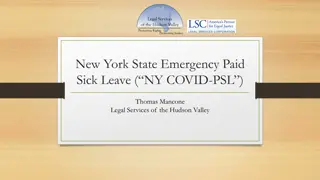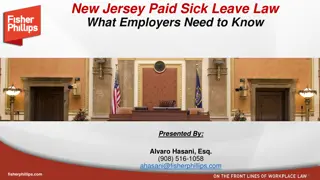Employment Law Considerations and Best Practices during COVID-19: Insights for Texas Employers
Explore key employment law considerations and best practices for Texas employers amidst the COVID-19 pandemic. Topics include paid leave benefits, responding to employee requests, transitioning back to the workplace, proper actions for positive cases, furloughs, and more. Discover insights from Executive Orders related to the Texas reopening plan and minimum recommended health protocols.
Download Presentation

Please find below an Image/Link to download the presentation.
The content on the website is provided AS IS for your information and personal use only. It may not be sold, licensed, or shared on other websites without obtaining consent from the author. Download presentation by click this link. If you encounter any issues during the download, it is possible that the publisher has removed the file from their server.
E N D
Presentation Transcript
Human Resources in the Time of COVID-19 Employment Law Considerations and Best Practices for Employers During the Pandemic TEXAS ASSOCIATION OF REGIONAL COUNCILS Finance and Personnel Staff Association Training & Meeting September 16, 2020 Emily R. Linn Lloyd Gosselink Rochelle & Townsend, P.C. www.lglawfirm.com
Governors Open Texas Plan and Tex. Dept. of State Health Services Minimum Health Protocols Paid leave benefits under Families First Coronavirus Response Act Responding to employee requests for leave or COVID-19 related accommodations. Transitioning back to the workplace, including tips for communicating with employees. Employee screening and temperature testing. Proper course of action when an employee tests positive for COVID-19, including who to notify and when. Furloughs, Lay-offs and Reductions in Force and Eligibility for Unemployment.
Takeaways from Executive Orders related to Opening State of Texas Texans should stay home/work home unless: 1) essential business or 2) accessing a re-opened service. General Rule = every business in Texas shall operate at no more than 50% of total capacity. Re-opened services without occupancy limits (religious services, local gov t operations, child-care services, youth-camps, recreational sports programs). Requires overrides of more restrictive local orders All Texans are required to wear a face covering over the nose and mouth in public spaces in counties with 20+ positive COVID-19 cases (with exceptions).
Minimum recommended protocols: Train on appropriate cleaning and disinfection, hand hygiene, and respiratory etiquette Screen entering employees before coming in the business and send home if: Cough, shortness of breath, chills, shaking, muscle pain, headache, sore throat Loss of taste/smell Diarrhea 100+ fever Known close contact with person with lab-confirmed virus Follow CDC guidelines on timeline for employee returning to work after testing positive or exposure to lab-confirmed positive person.
Conduct temperature checks of all employees at beginning of shift Employees must wash hands upon entering 6 feet social distancing If not possible, rigorously practice other measures face coverings, hand hygiene, cough etiquette, cleanliness Stagger meal and break time schedules to minimize close contact Encourage continued remote work Don t provide meals unless individually packaged Consider requiring face coverings
Regularly disinfect regularly touched surfaces Disinfect items outsiders touch Make hand sanitizer, wipes, soap and water readily available Place visible signage for everyone about hygiene practices Contactless payment is encouraged when available Consider appointing employee to manage and control access to facility Clean and sanitize the facility regularly, and at least daily For employers with 10+ employees present in person, consider appointing an employee dedicated to ensuring compliance with health protocols
As we begin to open Texas, we must continue to follow these critical health guidelines: Stay home if you can Wash hands often and for 20 seconds, or use hand sanitizer with at least 60% alcohol Cover coughs and sneezes with a tissue, then throw the tissue away Avoid touching your eyes, nose, and mouth with unwashed hands Disinfect surfaces, buttons, handles, doorknobs, and other places touched often Avoid close contact with people who are sick
Signed into law on March 18, 2020, took effect on April 1 and sunsets on December 31, 2020. Requires certain employers (most public employers and private employers with >500 employees) to provide emergency paid sick leave and emergency family and medical leave. Employers must post notice of the provisions of the FFCRA in open location. Recommend also emailing/direct mailing for those working remotely and requesting confirmation of receipt.
Emergency Paid Sick Leave: An employee qualifies for two weeks of emergency paid sick leave if unable to work because: the employee is subject to a quarantine or isolation order; the employee has been advised by a health care provider to self-quarantine due to concerns related to COVID-19 (belief that employee has or may have COVID-19 or is particularly vulnerable to COVID-19 (i.e. over 65 yrs of age, immunocompromised, etc.)); the employee is experiencing symptoms of COVID-19 and is seeking medical diagnosis; the employee is caring for an individual who is either subject to a quarantine or isolation order or has been advised to self-quarantine due to COVID-19; The employee is caring for his or her son or daughter whose school or place of care has been closed due to COVID-19, or whose child care provider is unavailable because of COVID-19 Expanded FMLA: employee qualifies for expanded FMLA leave (12 weeks of leave total, 10 paid at 66% of regular rate of pay) if unable to work because of child care needs. Employers can chose to either pay out benefits under FFCRA OR allow employee to continue to work from home.
New expanded FMLA leave to care for children whose schools are closed/available childcare. Virtual learning = school is closed, eligible for FFCRA leave. Parent s Choice (if employee has option to send to school or virtual learning) = school is NOT closed, can t take FFCRA leave. Hybrid (split time b/w in-person and remote learning) = closed when required remote learning, can take FFCRA leave during remote periods. DOL encourages collaborative discussion about flexibility.
Aug. 3, 2020 - NY federal district court struck down four parts of the FFCRA s final rule. In response, DOL issued revised regulations: Reaffirmed FFCRA leave may only be taken if the employer has work available from which employee can take leave Reaffirmed that FFCRA intermittent leave requires employer approval Narrowed the definition of health care provider Clarified timeline for when employee must provide notice of the need for leave and supporting documentation.
Remote Work as a Reasonable Accommodation Engage in interactive process under ADA to determine if employee s disability warrants an accommodation. Can ask questions/request medical documentation. If undue hardship to allow the employee to continue remote work, do not have to allow. Possible Alternative Reasonable Accommodations Temporary altering of job tasks/assignments to reduce contact with other employees/customers Installation of plexiglass barriers to ensure minimum distances Additional or enhanced PPE.
Request for Face Mask Accommodations An employee with a disability may need a related reasonable accommodation under ADA (e.g. non-latex gloves, modified face mask for interpreters or others who communicate via lip reading, gowns for individuals using wheelchairs). An employee could also seek a religious accommodation under Title VII (e.g., modified equipment due to religious garb). Employer should provide alternatives when feasible and not an undue hardship. NOT a reasonable accommodation to not wear a mask when in close contact with co-workers/public. Employer cannot affirmatively exclude employees from return to work solely because they have an underlying medical condition that the CDC says may pose a higher risk of severe illness if they contract COVID-19. Exception- employee s disability is a direct threat to his or her health that cannot be eliminated/reduced by reasonable accommodation.
Dont force employees 65+ or with medically documented vulnerable health issues back to work. Either provide work from home, or place on unpaid leave status after PTO/any available FFCRA leave is exhausted. TWC Guidance on unemployment eligibility (issued on 6/17/2020) Following area reasons benefits would be granted if individual REFUSED suitable work: Age or Medical Vulnerability Diagnosed with COVID-19 or Household member with COVID-19 Quarantined Childcare. As reimbursing employers, better to offer work from home rather than paying unemployment Still not eligible for FFCRA 80 hours paid emergency leave for this reason
Timeline for returning to work after positive test, exposure or travel: Quarantine Periods At least 3 days (72 hrs) have passed since recovery (resolution of fever without the use of fever- reducing medications); improvement in symptoms (e.g. cough, shortness of breath); and at least 10 days have passed since symptoms first appeared OR receipt of a medical professional s note clearing individual to return to work. (New CDC guidance, issued on 7/24/2020). DOL says should not require a negative test to return to work, BUT an employee may come back to work quicker if present negative test. Tested Positive: 10 day quarantine OR two negative test results with at least 24 hours between tests. Travel: 10 days symptom free OR two negative test results with at least 24 hours between test. Exposure to Person who tested positive: 14 days symptom free OR two negative test results with at least 24 hours between the test (must wait 3 days from exposure). Test should be approved by health professionals (nasal swab, saliva, etc.) Antibodies test not relevant.
EEOC says its okay to temperature check (No ADA concern). Best Practices for Temperature Testing Designate one management-level person to handle testing. Make sure individual understands how to use/sanitize equipment. No-touch thermometers preferred. Person administering test should be in PPE. If line forms, ensure employees are 6 ft. apart while waiting. If employee has a fever (100.0F), do not allow them to enter the workplace should go home and being quarantining. OSHA s Guidance on Returning to Work discusses temperature testing. Qualifies as biological monitoring. Any documentation qualifies as a medical record, triggering confidentiality obligations and retention period of 30 years. Records should be kept separate from personnel file (ADA). Recommend only recording positive temperature test (to reduce record retention burden).
Keep all COVID-19 records in separate medical file, including temperature logs/screening Can tell public health authorities of employee cases Coworkers? EEOC clarified anonymity required Question employee on close contacts at work, and then engage in contact tracing to determine who all cam in contact and let those know that a coworker with virus identified them Coworkers will figure it out quickly Getting employee s permission solves this
Can require a doctors note certifying fitness for duty, but practical concerns regarding unavailability of doctors/health care professionals. Alternatives: note from local clinics, or a stamp or email certification of negative test result. EEOC approved the followings actions: Employer checking applicant's temperature as part of a post-offer, pre- employment medical examination. Employer screening applicants for symptoms of COVID-19 after making a conditional job offer. Delaying the start date of an applicant who has COVID-19 or symptoms associated with it. Employer may withdraw a job offer when it needs the applicant to start immediately but the individual has COVID-19 or symptoms of it. Based on current CDC guidance, the individual cannot safely enter the workplace, and therefore the employer may withdraw the job offer.
Continue work at home if appropriate for employees job, even for partial days, to reduce workplace proximity. Develop plan for safely bringing back employees to office. Follow DSHS Minimum Protocols. Consider skeleton crew, phasing-in employees, establishing alternate work times/days in office to allow social distancing. Create policies and procedures to ensure social distancing (e.g., implementing one-way traffic patterns in office, moving workstation to increase distance, staggered shifts/lunch/rest breaks, establishing customer/visitor protocols, limited work travel etc.). Consider developing a retreat plan thinking about multiple re-starts and return to work from home. Ensure prepared with all testing equipment, PPE, cleaning and sanitizing products. Consistent and clear communication with employees explaining safety precautions and behavioral expectations (i.e., wear mask, truthfully respond to screening, etc.) Continue to have meetings via video conference Install 6-foot marker/plastic shield around receptionist Place hygiene guidelines where all can see.
What happens if an employee is unable or refuses to return to office? First determine why the employee is unable to return to the office. Fearful of returning to work? General anxiety vs. anxiety disorder or other mental health conditions (anxiety disorders, obsessive compulsive disorder, or post- traumatic stress disorder). High Risk Employee 65+ years old or medically-documented health condition. Family obligations that interfere with return to work? Employee under quarantine due to COVID-19 infection or exposure? Understanding possible liability: FFCRA coverage? ADA reasonable accommodations? Unemployment coverage?
Furlough keeps the employee employed, but no pay (or partial furlough/partial pay) Lay-off ends employment Reduction in Force (RIF) eliminates a position with no intent to replace. Steps to take to avoid claims of discrimination in layoffs and RIF: 1. list the employees who would be laid off or terminated based on your layoff/RIF criteria 2. determine whether certain groups of employees are affected more than others (race, age, gender, etc.) 3. if certain groups of employees are affected more than other groups, determine if you can adjust your layoff/RIF section criteria to limit impact on those groups, while still meeting business needs.
Employee is eligible for unemployment benefits if employment has been affected by COVID-19 i.e., the employee has lost full or partial pay. Defining unemployment: Total Unemployment earning 25% or less of weekly benefit. Partial Unemployment earning more than 25%, but less than 125%. General rule of thumb not worth applying for unemployment for less than 25% reduction BUT federal CARES Act enhanced unemployment compensation, $600/week, kicks in with any reduction Expired on 7/31/2020. FEMA Lost Wage Assistance Program -- Texas LWA program ended on 9/5/2020.
elinn@lglawfirm.com 512.322.5889 www.lglawfirm.com THANK YOU!
